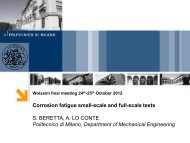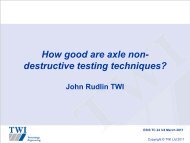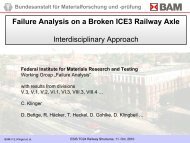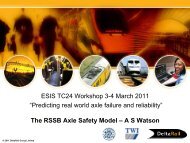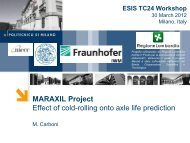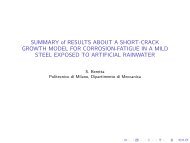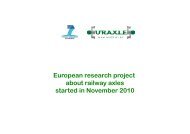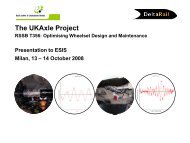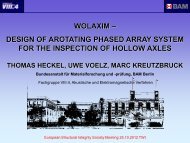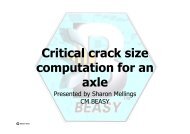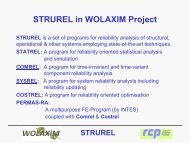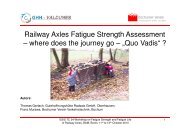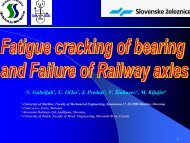Create successful ePaper yourself
Turn your PDF publications into a flip-book with our unique Google optimized e-Paper software.
ESIS <strong>TC24</strong> Workshop: Predicting real world <strong>axle</strong> failure and reliability<br />
3-4 March 2011 London<br />
<strong>Railway</strong> <strong>axle</strong> <strong>failures</strong> caused by corrosion and corrosion fatigue<br />
– the German experience<br />
Dr. Katrin Mädler, Deutsche Bahn AG, DB Systemtechnik<br />
Brandenburg-Kirchmoeser, Dept. Material engineering and damage analysis<br />
Deutsche Bahn AG<br />
DB Systemtechnik<br />
Dr. Katrin Mädler<br />
Brandenburg-Kirchmöser
Introduction<br />
DB Systemtechnik<br />
DB Systemtechnik<br />
� Provides technical engineering<br />
support to Deutsche Bahn AG and<br />
other railway traffic companies in<br />
Germany and Europe<br />
Key aspects of DB Systemtechnik<br />
Kirchmoeser<br />
� Vehicle and track maintenance support<br />
(technical consulting)<br />
� Non-destructive testing (Vehicles/<br />
Track)<br />
� Materials engineering and failure<br />
analysis (Vehicles/ Track)<br />
Deutsche Bahn AG, Katrin Mädler, T.TVI53, 4 March 2011<br />
2<br />
DB Systemtechnik locations<br />
� Minden: near Hannover<br />
� Munich (München)<br />
� Brandenburg-Kirchmoeser: near<br />
Berlin
Introduction<br />
Why a DB presentation at this workshop?<br />
ESIS TC 24 Workshop „Fatigue strength and fatigue life of railway <strong>axle</strong>s“<br />
Deutsche Bahn AG, Katrin Mädler, T.TVI53, 4 March 2011<br />
Berlin 11-12 October 2010<br />
While discussing causes of <strong>axle</strong> <strong>failures</strong> following questions were asked:<br />
- Is corrosion fatigue a common problem of <strong>axle</strong> <strong>failures</strong> in other countries than<br />
UK as well?<br />
- Do other railway companies know the „Hoddinott phenomenon“?<br />
� Deutsche Bahn representers were asked to present their experiences<br />
DB Experiences…<br />
- …are based on damage analysis work over several years as every failure<br />
event of wheels and <strong>axle</strong>s and a lot of failure events regarding track<br />
components (rails, S&C) has usually to be investigated by DB Systemtechnik<br />
Kirchmöser<br />
3
Introduction<br />
Wheelset <strong>axle</strong>s – philosophy of Deutsche Bahn<br />
Deutsche Bahn AG, Katrin Mädler, T.TVI53, 4 March 2011<br />
1st Safety level<br />
Wheelset <strong>axle</strong>s are designed according to DIN EN 13103/<br />
13104 to maintain a clear fatigue strength.<br />
That means <strong>axle</strong> loads below fatigue strength do not result in<br />
<strong>axle</strong> fatigue <strong>failures</strong> in service.<br />
In rare cases (related to the overall number of <strong>axle</strong>s in service)<br />
crack initiation at surface defects (arising<br />
from <strong>axle</strong> manufacturing and service resp.) may happen.<br />
2nd Safety level<br />
To check the <strong>axle</strong> for surface defects and to avoid possible<br />
crack initiation and crack growth until <strong>axle</strong> failure, <strong>axle</strong>s are<br />
subjected to ultrasonic testing on a regular basis.<br />
4
Wheelset <strong>axle</strong>s <strong>failures</strong><br />
Potential crack starters in general and DB experiences<br />
Note: There is no fatigue cracking without a crack starter (surface defect)!<br />
1. Wheel seat 2. Axle shaft and transitions<br />
� Fretting fatigue dimples<br />
� Hard non-metallic inclusions at<br />
or beneath the <strong>axle</strong> surface<br />
� Sharp-edged blasting particles<br />
of high hardness leave<br />
indentations at the wheel seat<br />
surface<br />
Deutsche Bahn AG, Katrin Mädler, T.TVI53, 4 March 2011<br />
What could be potential crack starters?<br />
5<br />
� Corrosion pits/ corrosion<br />
fatigue (if protection fails)<br />
� Stone impacts<br />
� Turning marks (grooves, offsets)<br />
and increased surface<br />
roughness<br />
� Hard non-metallic inclusions at<br />
or beneath the <strong>axle</strong> surface
Experiences of Deutsche Bahn with real <strong>axle</strong> <strong>failures</strong><br />
Example 1 - Freight wagon<br />
Wheelset <strong>axle</strong> breakage<br />
� Axle was first in salt transport service<br />
before installation in bulk transport<br />
� Running performance since last revision:<br />
~ 74,000 km<br />
Fracture position<br />
1/3 2/3<br />
Deutsche Bahn AG, Katrin Mädler, T.TVI53, 4 March 2011<br />
6<br />
Side A<br />
Side B
Experiences of Deutsche Bahn with real <strong>axle</strong> <strong>failures</strong><br />
Example 1 - Freight wagon<br />
Wheelset <strong>axle</strong> breakage<br />
A<br />
Fracture surface<br />
Deutsche Bahn AG, Katrin Mädler, T.TVI53, 4 March 2011<br />
Crack cluster B Single crack C<br />
Corrosion fatigue cracks at the surface<br />
Results of Magnetic particle testing (UV light)<br />
7<br />
A B C<br />
1/3 2/3
Experiences of Deutsche Bahn with real <strong>axle</strong> <strong>failures</strong><br />
Example 1 - Freight wagon<br />
Metallographic investigation of fracture initiation<br />
area A and crack positions B and C<br />
A – Near fracture position B – Crack cluster C – Single crack<br />
Deutsche Bahn AG, Katrin Mädler, T.TVI53, 4 March 2011<br />
8<br />
A B C<br />
1/3 2/3<br />
Corrosion pits with corrosion fatigue cracks at the pit ground<br />
Longitudinal micro-cross section (un-notched)
Experiences of Deutsche Bahn with real <strong>axle</strong> <strong>failures</strong><br />
Example 1 - Freight wagon<br />
Corrosion pits up to 0,4<br />
mm deep at the surface<br />
Note: sharpness of such<br />
corrosion notches is much<br />
higher than a semi-circular<br />
0,4 mm deep flaw<br />
Deutsche Bahn AG, Katrin Mädler, T.TVI53, 4 March 2011<br />
Position B – cluster of cracks<br />
Damage mechanism<br />
1. Local corrosion processes (salt transport wagon, aggressive medium)<br />
2. Roughening of <strong>axle</strong> surface by corrosion<br />
3. Superposition of mechanical loading: corrosion pits became sharper at the<br />
ground => Crack initiation at the ground of sharp corrosion pits<br />
4. Growth of corrosion fatigue cracks and coalescence (later on as one fatigue<br />
crack)<br />
9
Experiences of Deutsche Bahn with real <strong>axle</strong> <strong>failures</strong><br />
Example 2 - Passenger traffic<br />
Brake disk seat<br />
Crack<br />
Deutsche Bahn AG, Katrin Mädler, T.TVI53, 4 March 2011<br />
Wheel seat<br />
Corrosion protection paint seriously<br />
destroyed due to adhesion problems<br />
� Trailing <strong>axle</strong><br />
� Total running performance: ~ 450,000 km<br />
� Ultrasonic-testing (UT) revealed naked-eyevisible<br />
crack<br />
� After crack opening the fracture surface was<br />
investigated<br />
Fatigue crack between wheel seat<br />
and brake disk seat Corroded fatigue fracture<br />
surface with beach marks<br />
10
Experiences of Deutsche Bahn with real <strong>axle</strong> <strong>failures</strong><br />
Example 2 - Passenger traffic<br />
Metallographic investigation of crack initiation area<br />
Axle surface<br />
Corroded fracture face<br />
Deutsche Bahn AG, Katrin Mädler, T.TVI53, 4 March 2011<br />
Corrosion pit<br />
Longitudinal micro-cross section<br />
through the crack initiation point (X)<br />
X<br />
Result: Corrosion fatigue crack starting<br />
from a corrosion pit where the crack faces<br />
were deeply corroded<br />
Damage mechanism<br />
1. Surface corrosion protection layer was<br />
destroyed<br />
2. Corrosion fatigue processes as<br />
described before<br />
3. In addition: Slightly higher strength steel<br />
than A4T was used here => slightly<br />
higher notch sensitivity<br />
11
Experiences of Deutsche Bahn with real <strong>axle</strong> <strong>failures</strong><br />
Example 3 - Passenger traffic<br />
Multiple cracking in the transition range<br />
Results of Magnetic particle testing (UV light)<br />
Deutsche Bahn AG, Katrin Mädler, T.TVI53, 4 March 2011<br />
12<br />
� Driving <strong>axle</strong><br />
� Total running performance:<br />
~ 1,35 Million km<br />
� Higher strength Cr-Ni-Mo steel<br />
Tensile strength: ~ 1,000 MPa<br />
� Crack indications in the transition<br />
range were found by ultrasonic<br />
testing in the DB workshop<br />
� Investigation of DB Systemtechnik<br />
� Magnetic particle testing revealed<br />
crack cluster<br />
� Detailled investigation of longitudinal<br />
micro-cross sections perpendicular to<br />
the cracks
Experiences of Deutsche Bahn with real <strong>axle</strong> <strong>failures</strong><br />
Example 3 - Passenger traffic<br />
Deutsche Bahn AG, Katrin Mädler, T.TVI53, 4 March 2011<br />
13<br />
Result:<br />
� Cluster of corrosion<br />
fatigue cracks (Multiple<br />
cracking)<br />
� Corrosion products inside<br />
the crack reveal flowing<br />
direction of fluid corrosion<br />
medium
Experiences of Deutsche Bahn with real <strong>axle</strong> <strong>failures</strong><br />
Example 4 - Passenger traffic<br />
Transition range with multiple cracking<br />
Result of Magnetic particle testing (b/w)<br />
Deutsche Bahn AG, Katrin Mädler, T.TVI53, 4 March 2011<br />
14<br />
� Driving <strong>axle</strong><br />
� Total running performance:<br />
2,78 Million km<br />
� MT indications in the transition range<br />
between wheel seat and shaft were<br />
found in the DB workshop and<br />
confirmed by DB Systemtechnik´s<br />
investigation<br />
� Higher strength Cr-Ni-Mo steel was<br />
used (Tensile strength: ~ 1,000 MPa)<br />
� Investigation of longitudinal microcross<br />
sections perpendicular to the<br />
cracks
Experiences of Deutsche Bahn with real <strong>axle</strong> <strong>failures</strong><br />
Example 4 - Passenger traffic<br />
Deutsche Bahn AG, Katrin Mädler, T.TVI53, 4 March 2011<br />
Axle transition range with multiple cracking<br />
Longitudinal micro-cross section (un-etched)<br />
15<br />
Several micro-cracks<br />
over the whole<br />
transition length
Experiences of Deutsche Bahn with real <strong>axle</strong> <strong>failures</strong><br />
Example 4 - Passenger traffic<br />
Corrosion fatigue cracking in the transition range, longitudinal micro-cross section<br />
Left figure: un-etched Right figure: Nital etched<br />
Deutsche Bahn AG, Katrin Mädler, T.TVI53, 4 March 2011<br />
16<br />
Corrosion products<br />
inside the crack reveal<br />
flowing direction of fluid<br />
corrosion medium
Corrosion fatigue – General mechanism<br />
Interpretation of results<br />
Deutsche Bahn AG, Katrin Mädler, T.TVI53, 4 March 2011<br />
Corrosion fatigue in the active state 1)<br />
1. Concerning non-passivating un-alloyed or low alloyed steels<br />
2. Local corrosion attack � initiation of micro-notches<br />
3. Further corrosion processes concentrate at the micro-notches<br />
4. Concentration of mechanical stress at the notch tip (ground) shifts<br />
the electro-chemical potential to lower values and increases the<br />
metal dissolution � micro-notch growth<br />
1) Spähn, H.; Wagner, G. H.: Corrosion fatigue in steels. In:<br />
Bruchuntersuchungen und Schadenklärung. Allianz Versicherungs AG,<br />
München, Berlin, 1976, p. 59-74<br />
17
Corrosion fatigue – General mechanism<br />
Deutsche Bahn AG, Katrin Mädler, T.TVI53, 4 March 2011<br />
Corrosion fatigue in the active state 1)<br />
5. Opposite increase of mechanical stress concentration and metal<br />
dissolution<br />
� fatigue crack initiation<br />
� often multiple cracking because of presence of several<br />
micro-notches (pits)<br />
6. Fatigue crack growth perpendicular to the normal strength<br />
7. Final (residual) fracture: Fissured fracture surface due to<br />
combination of several cracks<br />
1) Spähn, H.; Wagner, G. H.: Corrosion fatigue in steels. In:<br />
Bruchuntersuchungen und Schadenklärung. Allianz Versicherungs AG,<br />
München, Berlin, 1976, p. 59-74<br />
18
Corrosion fatigue<br />
Influencing factors<br />
• Stress amplitude<br />
With higher amplitudes the mechanical effect of loading is prevailing and<br />
there are more cracks (multiple cracking)<br />
With lower amplitudes the corrosive effect becomes more important.<br />
• Materials strength<br />
Corrosion fatigue in the active state results in numerous micro-notches<br />
at the surface thus higher strength steels are more endangered due to<br />
their higher notch sensitivity.<br />
• Non-metallic inclusions<br />
Manganese sulfides play an important role if corrosion fatigue occurs,<br />
especially if pitting corrosion is regarded. (In contrast to normal fatigue,<br />
where MnS-inclusion do not affect crack initation/ growth so much.)<br />
Deutsche Bahn AG, Katrin Mädler, T.TVI53, 4 March 2011<br />
19
Conclusions<br />
1. Corrosion fatigue is a common damage mechanism for wheelset <strong>axle</strong>s. It<br />
occurs only if there are paint adhesion problems or if the protection paint was<br />
destroyed in service.<br />
2. The corrosion fatigue mechanism affects probably only the first crack growth<br />
phase up to a few millimeters of crack depth. Thereafter the mechanical (pure<br />
fatigue) damage mechanism is prevailing.<br />
3. Steels with a higher tensile strength are more notch sensitive. Accordingly,<br />
they are also more corrosion-pit-notch sensitive.<br />
4. However: Corrosion fatigue also works in freight wagon <strong>axle</strong>s of A1N steel. If<br />
<strong>axle</strong>s of higher strength steels are designed „thick enough“, corrosion, stone<br />
impacts and other defects will not cause more problems than A1N.<br />
5. To avoid <strong>axle</strong> <strong>failures</strong> due to corrosion fatigue, the corrosion protection of the<br />
<strong>axle</strong> surface has to be assured by maintenance workshops carefully.<br />
Deutsche Bahn AG, Katrin Mädler, T.TVI53, 4 March 2011<br />
20
Deutsche Bahn AG, Katrin Mädler, T.TVI53, 4 March 2011<br />
Thank you!<br />
For more questions please ak now or contact:<br />
Katrin Mädler, Deutsche Bahn AG, DB Systemtechnik<br />
katrin.maedler@deutschebahn.com<br />
Phone: +49 (0) 3381 812 337<br />
21



